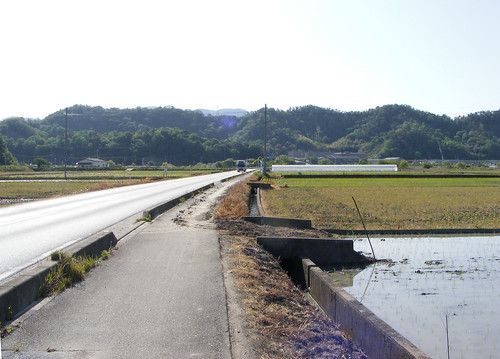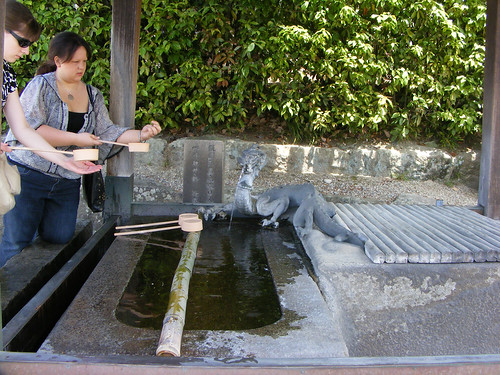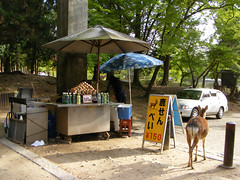
We've been in a lot of train stations. They always have kiosks and some places to grab a bite to eat. We've had many tickets (kippu) pass through our hands.

Our first stop in Nara was Horyu-ji. Before entering temples or shrines, you purify yourself by washing your hands and mouth. We just washed our hands, and it seemed like that's what most people were doing. Here's Hannah and Allison doing this.


Next, we ate lunch at a noodle place, and then we took a bus to Todai-ji. In a word, Todai-ji is amazing. It's the largest wooden structure in the world, possibly only rivaled by the Superior Dome. However, the Dome has NOTHING on this beautiful place. Certainly there is no 49' Buddha inside the Dome. The structure is just overwhelmingly gigantic as you walk up to it. Inside, the statues loom above you. Unfortunately, my pictures from inside were rather poor because it's quite dim inside. But you can understand some scale by looking at the people.


Horyu-ji is made up of several structures, including (to name a few) the kondo, pagoda, main hall, and yumedono. Beautiful place. It was very crowded and there were many groups of students being led through. Amusingly, many of the students were excited to see our group- especially the tall blondes in the group. Sometimes, they tried out their English on us too.
Here's a little bit of Horyu-ji
Here's a little bit of Horyu-ji


People lit incense before going inside. We did too. Our classmate Matthew (or part of him anyway) is in this photo as he lights incense. It smelled lovely.
There were other sculptures inside, too. It was really amazing to see all of this after having taken Japanese art history at NMU. Some of these art pieces are from a very, very long time ago and have survived in respectable condition. The craftsmanship is remarkable, and the survival of the works (including architecture) is a testament to that. Also inside the building, a gift shop with many, many Buddha and deer souvenirs. Jorie was excited, to say the least. I picked up a bunch of small gifts for friends at home, and some beautiful handkerchiefs.
The day was kind of a blur because we were moving around so much, but I forgot to mention the deer of Nara. As soon as we arrived at Todaiji, we saw the deer. They're everywhere. They're considered sacred, so they're allowed to do whatever they want! Again, Jorie was veeery excited, which is why she's making a separate post just about this deer business. So I'll just say that we all enjoyed feeding the deer Shika Senbei, or deer crackers. Here's one waiting smartly by the senbei kiosk.


There were other sculptures inside, too. It was really amazing to see all of this after having taken Japanese art history at NMU. Some of these art pieces are from a very, very long time ago and have survived in respectable condition. The craftsmanship is remarkable, and the survival of the works (including architecture) is a testament to that. Also inside the building, a gift shop with many, many Buddha and deer souvenirs. Jorie was excited, to say the least. I picked up a bunch of small gifts for friends at home, and some beautiful handkerchiefs.
The day was kind of a blur because we were moving around so much, but I forgot to mention the deer of Nara. As soon as we arrived at Todaiji, we saw the deer. They're everywhere. They're considered sacred, so they're allowed to do whatever they want! Again, Jorie was veeery excited, which is why she's making a separate post just about this deer business. So I'll just say that we all enjoyed feeding the deer Shika Senbei, or deer crackers. Here's one waiting smartly by the senbei kiosk.

It was a very amazing day indeed. We walked a LOT though, and, after taking several (EXTREMELY crowded) trains home, we had to walk the several miles back to JCMU. In the dark. At some point, one of our classmates fell ill and we had to get her a ride back. We were all very concerned but she was okay, thankfully. Most of us opted to walk back after that (rather than get a ride in the car)- Jorie and I wanted to hear the kaeru (frogs) and mushi (insects) at night. We did. The rice paddies are everywhere, so the frogs are also everywhere. They sounded a lot like peepers, with other kinds of frogs joining in too. Instead of ribbit, frogs in Japan say kerokero or gerogero. We also saw stars (hoshi) in the sky, and lovely reflections on the rice paddies. We loved it, but we were also walking on very sore feet. We stopped at the Lawson's convenience store, and then went back to the apartment. Jorie bought a beer, drank it, and then quickly fell asleep.



What a great day! Thanks for keeping up with the blog postings. I love to read what you and Marjorie write.
ReplyDelete